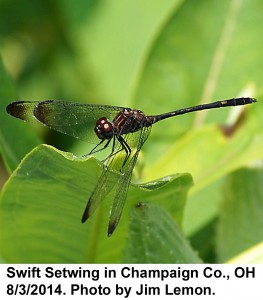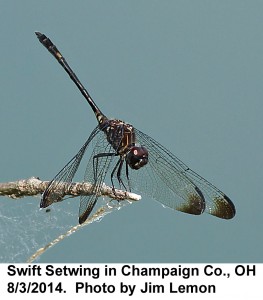Here’s an update from Bob Glotzhober about the new dragonfly:
 Last week we posted about the discovery of an additional species of dragonfly that was found in Ohio. The find of a male Swift Setwing (Dythemis velox) not far from Urbana in Champaign County increases the number of dragonflies and damselflies known from Ohio to 164 species.
Last week we posted about the discovery of an additional species of dragonfly that was found in Ohio. The find of a male Swift Setwing (Dythemis velox) not far from Urbana in Champaign County increases the number of dragonflies and damselflies known from Ohio to 164 species.
As noted previously, each time the sightings were made, no more than a single male Swift Setwing had been seen. But sightings in the same general area a few miles from Urbana were made on multiple dates: July 25th, August 2nd, August 3rd, August 7th, and on August 9th. Sightings stretched out over two weeks plus the fact that the first sighting was an immature adult, all suggested that there might be more than one individual, and that they had emerged from larvae living in the lake where find was made.
Last Thursday, August 14th, Jim Lemon and I checked out five different locations, searching for the Swift Setwing. First we explored three nearby access points to the Mad River. Swift Setwings are reported to prefer slow to moderately moving streams and rivers, and the lake where the sightings have been drains into the Mad River. We spent variously 40 minutes, ten minutes and twenty minutes at the three spots. While such limited time cannot totally exclude the possibility that they are using the river, we saw no indication of such during this preliminary search.

Finally, we traveled a bit north of Urbana to search several ponds belonging to Freshwater Farms of Ohio. We knew that this aqua-culture venture had imported shrimp from Gulf coastal areas and perhaps other animals and plants along with them, so we wanted to see if their ponds were supporting any Swift Setwings. Again, our search was limited in time, and we could not totally rule this potential source out, but while we saw a number of dragonflies and damselflies no Setwings were seen.
In summary, it appears that there is at least a small population of Swift Setwings at the private lake where Jim Lemon first discovered the species. While we saw no females, it is not uncommon for females to both emerge later than males, and to stay away from territorial breeding sites except when they come to mate and oviposit. So not seeing any females certainly does not mean they are not there. The test will be continued observations, especially observations next summer to see if eggs have been laid and another generation of Swift Setwings is established in this new habitat.
Bob Glotzhober
Curator Emeritus of Natural History